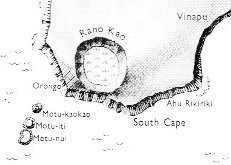|
"Maui
was the fifth and youngest of his parents' sons, yet when he was
born his brothers knew nothing of it. They first learned that
they had a brother when he was discovered one night standing
behind them in the great meeting house.
Everyone was present, the four brothers, their mother Taranga,
and all the relations, and there was dancing going on, when
little Maui crept into the house unseen, and went and sat
behind his brothers. When it came to their turn to dance, and
their mother stood them up and counted the so as to be ready, he
stood up with them.
'One, that's Maui mua; two, that's Maui roto;
three, that's Maui taha; four, that's Maui pae',
she said; these names mean Maui the first, Maui
the middle, Maui the side, and Maui the edge. Then
she saw this other child standing with them, and cried out,
'Hullo, where did this one come from?'
'I'm your child too', Maui replied. So she counted them
again and said, 'Oh no, there ought to be only four of you. This
is the first I've seen of you.'
And
so there was a scene, with little Maui and the old woman
arguing about it in the middle of the rows of dancers. In the
end she became annoyed with him. 'Now, come on, out of the
house!' she said. 'You are no child of mine, you belong to
someone else. Go home!'
But
little Maui stood up for himself. 'Well then, I'd better
go, I suppose', he said. 'Since you say so, I must be someone
else's child. But I did think I was yours, because I know I was
born at the edge of the sea, and you cut off a tuft of your hair
and wrapped me in it and threw me in the waves. After that the
seaweed took care of me and I drifted about in the sea, wrapped
in long tangles of kelp, until a breeze blew me on shore again,
and some jelly-fish rolled themself around me to protect me on
the sandy beach. Clouds of flies settled on me and I might have
been eaten up by the maggots; flocks of seabirds came, and I
might have been pecked to pieces. But then my great-ancestor
Tama nui ki te rangi arrived. He saw the clouds of flies and
all the birds, and he came and pulled away the jelly-fish, and
there was I, a human being! Well, he picked me up and washed me
and took me home, and hung me in the rafters in the warmth of
the fire, and he saved my life. And I grew, and eventually I
heard about the dancing you have here in this house, and that is
what brought me here tonight.'
Now
Taranga listened to all this in amazement. For in the
custom of our people, if a child was born before it finished
growing in its mother's womb and died without knowing any of the
pleasures of life, it was supposed to be buried with special
prayers and ceremonies, otherwise it became a kind of evil
spirit, always doing mischief to the human race and hurting them
out of spite, because of having missed the happiness that they
enjoy. All the evil spirits had a beginning of this sort. So
Maui was a little demi-god of mischief. The story he had
told was true, and as his mother listened she remembered it all.
'From the time I was in your womb,' Maui went on, 'I have
known the names of these children of yours. Listen,' he said as
he pointed to his brothers in turn. 'You are Maui mua,
you are Maui roto, you are Maui taha, and you are
Maui pae. And as for me, I am Maui potiki, Maui-the-last-born.
And here I am.'
When he had finished, Taranga had to wipe her eyes
because there were tears in them, and she said: 'You are indeed
my lastborn son. You are the child of my old age. When I had
you, no one knew, and what you have been saying is the truth.
Well, as your were formed out of my topknot you can be Maui
tikitiki a Taranga.'
So
that became his name, meaning Maui-formed-in-the-topknot-of-Taranga.
And this is very strange, because women in those days did not
have topknots. The topknot was the most sacred part of a person,
and only men had them."
(Maori Myths) |





































































